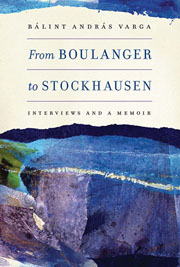Book contents
- Frontmatter
- Dedication
- Contents
- Foreword
- Acknowledgments
- Part One Interviews
- Part Two A Memoir
- Introduction
- Chapter 1 Ancestors
- Chapter 2 On Being Jewish
- Chapter 3 Growing Up in Postwar Socialist Hungary
- Chapter 4 Margit
- Chapter 5 Tapespondence
- Chapter 6 Birth and Demise of a (Counter)revolution: A Boy's-Eye View
- Chapter 7 Broadcasting 1
- Chapter 8 Broadcasting 2
- Chapter 9 Editio Musica Budapest
- Chapter 10 Interviewing: An Obsession
- Chapter 11 Ich war ein Berliner
- Chapter 12 Moving to Vienna
- Chapter 13 Universal Edition
- Chapter 14 Back Catalogue
- Chapter 15 The Psychology of Promotion
- Chapter 16 Farewell and After
- Notes in Retrospect
- Index
- Miscellaneous Endmatter
Chapter 12 - Moving to Vienna
from Part Two - A Memoir
Published online by Cambridge University Press: 05 January 2014
- Frontmatter
- Dedication
- Contents
- Foreword
- Acknowledgments
- Part One Interviews
- Part Two A Memoir
- Introduction
- Chapter 1 Ancestors
- Chapter 2 On Being Jewish
- Chapter 3 Growing Up in Postwar Socialist Hungary
- Chapter 4 Margit
- Chapter 5 Tapespondence
- Chapter 6 Birth and Demise of a (Counter)revolution: A Boy's-Eye View
- Chapter 7 Broadcasting 1
- Chapter 8 Broadcasting 2
- Chapter 9 Editio Musica Budapest
- Chapter 10 Interviewing: An Obsession
- Chapter 11 Ich war ein Berliner
- Chapter 12 Moving to Vienna
- Chapter 13 Universal Edition
- Chapter 14 Back Catalogue
- Chapter 15 The Psychology of Promotion
- Chapter 16 Farewell and After
- Notes in Retrospect
- Index
- Miscellaneous Endmatter
Summary
The invitation from Vienna and my eager acceptance of it set a process in motion that was to introduce a new chapter in our lives: leaving Hungary behind, in other words emigrating, and settling permanently in Austria.
Austria, like Hungary, had been an ally of Nazi Germany, with a large section of the population enthusiastically welcoming the Anschluss, the country's takeover by Hitler in 1938. Like Hungary, it had lost World War II, but the State Treaty of 1955 ensured its independence, ending the occupation by Allied forces. Österreich ist frei! “Austria is free!” Foreign Minister Leopold Figl announced on May 15, 1955, from the balcony of Belvedere Palace. The Soviet foreign minister, Viacheslav Molotov, who was standing right next to him, did not so much as bat an eyelid. The Soviet troops left Austria but they stayed on in Hungary for more than three decades; there was no knowing how much longer we would be playing host to what was officially described as the “Soviet army temporarily stationed in Hungary.”
Ever since 1955, Austria has been a neighbor much envied and admired from the Hungarian side of the border. Austria's development into a prosperous neutral country in the middle of Europe demonstrated the alternative that remained out of reach for Hungary, separated as it was from the free world by a barbed wire fence and landmines. Austria was and is a country Hungary might have become but has not.
- Type
- Chapter
- Information
- From Boulanger to StockhausenInterviews and a Memoir, pp. 336 - 341Publisher: Boydell & BrewerPrint publication year: 2013



